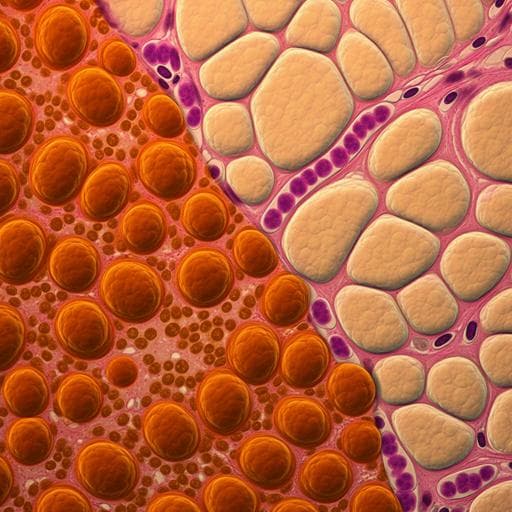
Medicine and Health
Maternal high-fat diet programs white and brown adipose tissue lipidome and transcriptome in offspring in a sex- and tissue-dependent manner in mice
C. Savva, L. A. Helguero, et al.
This research reveals how a maternal high-fat diet influences the metabolic profile of offspring differently based on sex. While female offspring experience beneficial metabolic adaptations, male offspring face adverse changes. The study conducted by Christina Savva and colleagues offers intriguing insights into the long-term health implications of maternal diets.
~3 min • Beginner • English
Introduction
Global increases in consumption of calorie-dense, industrially modified fats alongside sedentary behavior have strained human metabolism. The rising prevalence of obesity among women of reproductive age raises concern for fetal health. Offspring show high sensitivity to nutritional environments during prenatal, neonatal, and postnatal periods, predisposing to adult metabolic complications. Maternal high-fat diet (moHF) can induce intrauterine programming through gene regulation, fostering transgenerational transmission of metabolic risk. Sex-dependent adaptations to maternal obesity have been observed, but underlying mechanisms remain unclear. Adipose tissue (AT) is metabolically active, with white and brown adipocytes regulating energy balance; AT development occurs during prenatal and postnatal windows, suggesting moHF could program AT function. This study investigates how moHF before and during gestation/lactation affects offspring WAT and BAT under post-weaning HFD, focusing on sex- and depot-specific metabolic, lipidomic, and transcriptomic changes.
Literature Review
Prior studies show offspring are highly sensitive to prenatal and early postnatal nutrition, with maternal obesity and high-fat diet linked to epigenetic and transcriptional programming that elevates adult metabolic disease risk. Sex-dependent metabolic adaptations to maternal HFD have been reported, but mechanisms are unresolved. Adipose tissue remodeling affects metabolic homeostasis, with depot- and sex-specific differences influencing insulin resistance and inflammation. Evidence indicates BAT lipid profiles are sex-specific and BAT triglyceride content associates with insulin resistance. Work on X- and Y-linked gene dosage suggests sex chromosome complement contributes to adiposity and metabolic dimorphism. Collectively, literature supports that maternal diet may induce sex- and depot-specific programming of adipose biology.
Methodology
Animal model: Four-week-old C57BL/6J virgin dams were acclimated and randomized to control diet (10% kcal fat; n=6) or high-fat diet (45% kcal fat; n=6) for 6 weeks prior to mating, and maintained on the same diet during gestation and lactation. Sires remained on control diet except during a short mating period. Offspring (F1) were weaned at postnatal day 21 and fed HFD until study end. Housing at 23 °C, 12 h light/dark, ad libitum feeding. Experimental timeline: Assessments at midterm (~14 weeks) and endterm (~25 weeks). In vivo imaging/spectroscopy: Whole-body and regional adiposity quantified by MRI (9.4 T magnet, millipede coil). Localized 1H-MRS acquired from VAT (upper gonadal) and SAT (inguinal) voxels to quantify triglyceride fatty acid features (mean chain length, saturation proportions). Histology: H&E staining of VAT and SAT to assess adipocyte size (hypertrophy) and number (hyperplasia). Plasma biochemistry: Tail blood for fasting glucose (6 h fast) and insulin (4 h fast); derived indices included HOMA, Matsuda index, and AUCins:AUCglc. Lipidomics: BAT triglycerides profiled by LC-MS/MS with class and species-level identification (TG40–TG56), and fatty acids by GC-FID after transmethylation. Transcriptomics: RNA extracted from VAT, SAT, BAT; Smart-Seq2 libraries sequenced (HiSeq3000, single-end 50 bp). Reads trimmed, mapped to mm10 (TopHat2/Bowtie2), counted (featureCounts), and differential expression analyzed (DESeq2; BH FDR<0.1). Pathway analysis: KEGG gene set enrichment; visualization via bubble charts and chord plots for insulin/glucose, inflammatory, oxidative, and lipid metabolism pathways. Statistics: Two-way ANOVA (sex, maternal diet) with Tukey post hoc where applicable; unpaired t-tests with Holm–Sidak correction for selected comparisons; significance p<0.05; FDR<0.1 for RNA-seq.
Key Findings
- Body composition and adipose depots: At midterm, male offspring of moHF dams (M-moHF) accumulated less total fat than male controls; at endterm, females had more total fat than males. At midterm only, females displayed lower VAT% and higher SAT% than males. M-moHF VAT showed hyperplasia with reduced hypertrophy versus M-moC and F-moHF; in SAT, males exhibited hypertrophy and reduced hyperplasia compared to females. - Plasma metabolism: At midterm, fasting glucose was higher in M-moHF than F-moHF (e.g., ~13.0±1.2 vs 7.6±0.5 mM); in moC, glucose was similar between sexes. Insulin and HOMA were higher in males than females, with moHF increasing insulin in females at midterm. Matsuda index was higher in females than males; moHF reduced it in females at midterm. At endterm, β-cell function (AUCins:AUCglc) was impaired in M-moC vs F-moC and moHF impaired females. - WAT triglyceride composition (1H-MRS): VAT mean chain length (MCL) unchanged across groups; SAT MCL at midterm was reduced by moHF in males; at endterm, F-moC had longer SAT MCL than M-moC and moHF increased MCL and Elovl7 expression in males. VAT at midterm: fraction of saturated lipids (fSL) higher in F-moC than M-moC; moHF decreased fSL in females and increased it in males. SAT at midterm: M-moHF had lower fSL than F-moHF and M-moC; at endterm, fSL higher in males. VAT at midterm: fraction of monounsaturated lipids (fMUL) increased by moHF in females to levels higher than in males; SAT fMUL increased by moHF in males at midterm. VAT fPUL reduced by moHF in males at midterm; SAT fPUL higher in F-moC than M-moC but reduced by moHF in females at endterm. - WAT transcriptome: Clear depot heterogeneity (VAT vs SAT) and sex clustering. moHF effects were largely sex-specific; in males, moHF strongly modulated SAT transcriptome. In VAT, moHF upregulated lipolysis and downregulated PPAR signaling and fatty acid synthesis pathways in females; in SAT, moHF upregulated oxidative phosphorylation but downregulated TCA in females and downregulated oxidative pathways in males. Lipid metabolism genes showed sex- and diet-dependent regulation: Dgat2 reduced by moHF in females and increased in males (VAT); Sfrp4 induced by moHF in females and reduced in males (both depots); higher Sfrp4 in F-moHF than M-moHF. - BAT morphology and lipidomics: Males had approximately twice the BAT volume and 20% higher triglyceride content than females, with higher expression of Cd36, Cpt1, Plin2, and Fabp1. TG class distribution differed by sex; in females, moHF decreased TG50 and increased TG54 classes. Among 54 TG species, 17 showed sex differences in moC (only 2 in moHF), with extensive remodeling in females under moHF (15 species). Saturation profiles were sex-dependent; moHF altered saturation in females only. Total ω3 and ω6 fatty acids were higher in females and males, respectively; ω6/ω3 ratio increased by moHF in males, indicating a more adverse metabolic profile. - BAT transcriptome and pathways: Most moHF-driven differentially expressed genes (DEG) occurred in females (~80%), but lipid metabolism pathway activity shifts were prominent in males. In females, moHF downregulated oxidative phosphorylation and metabolic pathways, while upregulating immune/inflammatory processes and insulin secretion; in males, moHF downregulated cell proliferation/survival and upregulated metabolic pathways, including oxidative phosphorylation genes (e.g., Atp5k, Cox8b, Cox7a1, Ndufa3 in males only). Insulin/glucose pathways: moHF upregulated insulin secretion but downregulated insulin signaling in females and downregulated insulin pathways in males; baseline insulin/glucose pathway gene expression was higher in females. Inflammation: Higher in males at baseline; moHF induced inflammatory pathways in females and increased inflammatory signaling in males in WAT. Thermogenesis: In males, moHF increased Cidea and Pparg but decreased Ucp1; in females, moHF increased Ucp1, Dio2, Ppara, Pparg and decreased Pgc1a; β3-adrenergic receptor (Adrb3) increased in females. Sex hormone receptors: ESR1 higher in F-moC than F-moHF and M-moC; AR unchanged. - Sex chromosome contributions: Multiple X-linked genes associated with glucose metabolism and adipose development (e.g., G6pdx, Pfkb1, Fmr1, Kdm5c) were higher in females in VAT; SAT showed X-linked beiging/adipogenesis signatures (Itm2a, Flna, Cited1, Arxes1/2, Cox7b) with reduced X-linked DEG under moHF. Y-linked genes (e.g., Ddx3y, Eif2s3y) were upregulated in males, supporting a sex chromosome signature.
Discussion
The study demonstrates that maternal high-fat diet programs adipose tissue lipid composition and gene expression in offspring in a sex- and depot-specific manner, even when all offspring consume HFD post-weaning. This addresses the hypothesis that prenatal and early life nutritional environments impart sex-dependent programming of adipose metabolism. In females, maternal HFD appears to drive adaptive remodeling—altering WAT and BAT triglyceride profiles and enhancing BAT thermogenic capacity (Ucp1, Dio2, Adrb3)—which may help maintain metabolic balance despite increased energy intake. In males, maternal HFD promotes VAT hyperplasia, systemic and adipose inflammation, and BAT whitening with an adverse ω6/ω3 shift, aligning with impaired insulin sensitivity and thermogenic function. Transcriptomic analyses support these phenotypes, revealing sex-specific regulation of lipid metabolism, oxidative phosphorylation, insulin/glucose signaling, inflammatory pathways, and adipogenesis-related genes (e.g., Sfrp4, Dgat2). The attenuation of sex differences in certain BAT pathways under maternal HFD suggests reprogramming that narrows baseline dimorphism. The identification of sex-chromosome-linked gene expression differences further implicates genetic dosage effects in mediating sexual dimorphism of adipose biology. Collectively, findings highlight that maternal diet primes adipose depots differently in male and female offspring, influencing trajectories toward metabolic health or dysfunction.
Conclusion
Maternal high-fat diet prior to and during pregnancy and lactation reprograms offspring adipose tissue lipidome and transcriptome in a sex- and depot-dependent fashion. Female offspring exhibit triglyceride remodeling in SAT and BAT and increased BAT thermogenic gene expression, consistent with a more balanced metabolic profile. Male offspring display VAT hyperplasia, heightened inflammatory signaling in WAT, BAT whitening, and a higher ω6/ω3 ratio, indicating impaired metabolic adaptation. These sex-specific programming effects likely contribute to differential risks of metabolic disorders later in life and underscore the need for sex- and tissue-targeted prevention and therapies. Future research should delineate causal mechanisms linking specific lipid species and pathway changes to metabolic outcomes, define the roles of X- and Y-linked genes in adipose programming, and test interventions that modulate maternal diet or early-life environments to improve offspring metabolic health.
Limitations
Related Publications
Explore these studies to deepen your understanding of the subject.







